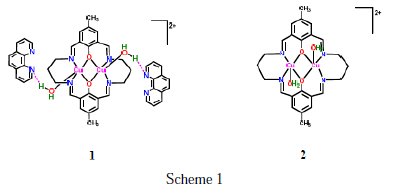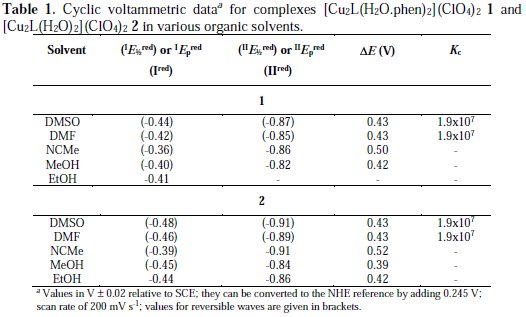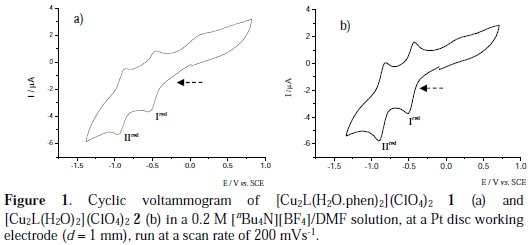Serviços Personalizados
Journal
Artigo
Indicadores
-
 Citado por SciELO
Citado por SciELO -
 Acessos
Acessos
Links relacionados
-
 Similares em
SciELO
Similares em
SciELO
Compartilhar
Portugaliae Electrochimica Acta
versão impressa ISSN 0872-1904
Port. Electrochim. Acta vol.33 no.4 Coimbra jul. 2015
https://doi.org/10.4152/pea.201504201
Electrochemical Properties of Robson Type Macrocyclic Dicopper(II) Complexes
Elisabete C. B. A. Alegriaa,b,* , Sellamuthu Anbub , Luisa M.D.R.S. Martinsab and Armando J.L. Pombeirob,*
a Chemical Engineering Department, ISEL-Instituto Superior de Engenharia de Lisboa, Instituto Politecnico de Lisboa, 1959-007 Lisboa, Portugal
b Centro de Quimica Estrutural, Instituto Superior Tecnico, Universidade de Lisboa, Av. Rovisco Pais, 1049-001 Lisboa, Portugal
Abstract
The redox properties of the 1,10-phenanthroline containing Robson type symmetrical macrocyclic dicopper(II) complex [Cu2L(H2O.phen)2](ClO4)2 1 (L = μ-11,23-dimethyl3,7,15,19- tetraazatricyclo-[19.3.1.18 19,13,21] heptacosa-1(24),2,7,9,11,13(26), 14,19,21(25),22-decaene-25,26-diolate) and of its dicopper(II) precursor [Cu2L(H2O)2](ClO4)2 2 have been investigated by cyclic voltammetry and controlled potential electrolysis in different organic solvents. They exhibit two consecutive reversible one-electron reductions assigned to the CuIICuII → CuICuII → CuICuI cathodic processes. The results suggest that, in solution, phenanthroline does not coordinate to the metal in complex 1, but its H-bonding interaction with the water ligands can be preserved.
Keywords: Robson type macrocyclic dicopper(II) complexes, 1,10-phenanthroline, cyclic voltammetry, controlled potential electrolysis.
Introduction
The presence of metal-binding sites in DNA structure makes it a good target for metal-containing drugs, since it plays a central role in replication, transcription and regulation of genes [1-3].
Over the past few decades, several phenanthroline based mononuclear Cu(II) complexes were synthesized and their interactions with DNA and cytotoxic activities [1-3] were reported. These works are mainly limited to mononuclear complexes and very few studies on dinuclear complexes with metal ions in close proximity were reported to date [4,5]. Recently, some of us synthesized phenanthroline based dicopper(II) complexes, which strongly bind to DNA and also regulate apoptosis [6,7]. In this context, a novel phenanthroline containing Robson type symmetrical macrocyclic dicopper(II) complex [Cu2L(H2O.phen)2](ClO4)2 1 was obtained by reacting the reported Robson type macrocyclic precursor dicopper(II) complex [Cu2L(H2O)2](ClO4)2 2 and 1,10-phenanthroline in ethanol [8]. X-ray crystallography reveals that, in the solid state, 1,10-phenantroline nitrogens interact with the copper(II) centres through H- bonds with the coordinated water. However, analytical, UV-vis, ESI-MS and EPR spectral data suggest that the 1,10-phenanthroline molecules are replacing the coordinated water molecules in 2, affording a 1,10-phenanthroline coordinated macrocyclic dicopper(II) complex in solution with a different metal coordination geometry. Nevertheless, this matter has not been fully clarified [8]. The catalytic activity of complexes 1 and 2 towards the hydrolysis of 4- nitrophenyl phosphate, DNA binding, cleavage and preliminary anticancer properties was studied [8]. Complex 1 displays better DNA binding and significant cleavage activity than 2. The influence of the phenanthroline moiety on the phosphate hydrolysis, DNA binding, cleavage and anticancer properties of complex 1 has also been studied. The dicopper(II) complexes 1 and 2 showed cytotoxicity in human cervical HeLa cancer cells, giving IC50 values of 15.82 and 79.41 μM, respectively. Antiproliferative effect of 1 and 2 were confirmed by Trypan blue Exclusive assay and lactate dehydrogenase level in HeLa cancer cell lysate and content media [8].
Herein we report the electrochemical properties of complexes 1 and 2 using cyclic voltammetry (CV) and controlled potential electrolysis (CPE) techniques, aiming also to further contribute to clarify the structure of 1 in solution, namely the eventual replacement (or not) of the water ligands by phenanthroline molecules.
Results and discussion
The redox properties of the compounds [Cu2L(H2O.phen)2](ClO4)2 1 and [Cu2L(H2O)2](ClO4)2 2 (Scheme 1) have been investigated by cyclic voltammetry (CV), at a Pt electrode, in various organic solvents, using a 0.2 M [nBu4N][BF4] solution, at 25 °C.

Results are summarized in Table 1 and Fig. 1.


The cyclic voltammograms of these dicopper(II) complexes exhibit a first single- electron reversible (in DMSO, DMF, NCMe and MeOH) or irreversible (in EtOH) reduction wave (see wave Ired, Fig. 1, for 1 and 2 in DMF, Table 1) and, at a lower potential, a second single-electron reversible (in DMSO and DMF) or irreversible (in NCMe, MeOH and EtOH) reduction (see wave IIred, Fig. 1, for 1 and 2 in DMF), at the reduction potential values given in Table 1 (IEredp in the range from -0.36 to -0.48 V vs. SCE, and IIEredp between -0.82 and -0.91 V vs. SCE).
The occurrence of single-electron reductions (Ired and IIred) has been confirmed by exhaustive controlled potential electrolysis (CPE) at a potential slightly cathodic to that of the peak potential of wave Ired or IIred. CPE at any of the reduction waves corresponds to a charge consumption of 1 F/mole of complex.
The above observations can be rationalized, for reversible waves, by Scheme 2, involving the stepwise CuII → CuI reduction of one Cu centre to form a mixed- valence CuIICuI species (wave Ired) followed by the reduction of the second Cu centre to yield the corresponding CuICuI complexes (wave IIred).

No oxidation has been detected, for any of the complexes, by a first anodic sweep without a previous reduction scan, indicating that neither a metal centred nor a ligand-centred oxidation is observed.
The electrochemical behaviour of the symmetrical macrocyclic dicopper(II) complexes 1 and 2 is consistent with that previously reported for other related symmetrical and unsymmetrical binuclear copper(II) complexes [9,10].
Comparison of the CuII/CuI redox potentials in various solvents showed a good correlation between half-wave potentials and the solvent electron pair donation ability, being the most negative potential recorded in DMSO and DMF and the less negative in NCMe [11,12], as observed in the present study.
The observation of the two distinct reduction waves Ired and IIred is indicative of an electronic communication between the two metals, which is reflected on the half-wave potential difference and the comproportionation constant Kc i.e. the equilibrium constant of reaction (eq. 1), which is given by the expression Kc = exp(|n1Eo1 - n2Eo2|F/RT) = exp(|n1Eo1 - n2Eo2|/25.69) (at 298 K, with Eo in mV) [13].

In our case, for the reversible processes, n1= n2 = 1 electron, |Eo1 - Eo2| = |IE1/2ox - IIE1/2ox| = 430 mV (Table 1), leading to the high value of Kc = 1.9 × 107, indicative of a Robin-Day class III system [14,15]. This shows a strong electronic interaction between the two metals, via the bridging groups and a high stabilization of the mixed-valence CuICuII state. The comproportionation constant value observed for our bimetallic copper complexes 1 and 2 is in the range of the Kc values observed for other Robson type macrocyclic dicopper(II) complexes (5.1×107 < Kc < 2.4×1012) [16,17]. Comparing the Kc value obtained for the system under study with the one for other bimetallic systems studied by us, we can conclude, for example, that the interaction between the copper centres in 1 and 2 (Kc = 1.9 × 107, in DMf or DMSO) is stronger than that observed between molybdenum centres, via bridging pyridylpyrazolate groups, in [cis-{Mo(η3-allyl)(CO)2(μ 2-pypz)}]2 (Kc = 1.2 × 106, in CH2Cl2) [18] or between iron centres in the dinuclear iron(II)hydride complex with a bridging nitrile [{FeH(dppe)2}2(m-LL)][BF4]2 (LL = NCCH=CHCN; dppe = Ph2PCH2CH2PPh2) (Kc = 1.6 × 103, in CH2Cl2) [19].
Although 1 and 2 exhibit almost identical reduction potentials (the differences are only of ca. 0.04~0.05 V), there appears to occur a minor systematic difference.
The less very slightly cathodic reduction potential of [Cu2L(H2O.phen)2](ClO4)2 1, in all organic solvents used in this study, in comparison with that of the parent [Cu2L(H2O)2](ClO4)2 2, indicates a slightly lower electron-donor character of the ligands present in 1 relatively to those present in 2. This behaviour is in agreement with the expected [20] effect in solution of H-bond interaction, in 1, of the 1,10-phenanthroline molecules with the water ligands as revealed by X-ray crystallography of 1 in the solid state [8].
Moreover, such a minor difference of reduction potentials between 1 and 2 is not consistent with the replacement, in solution, of the ligated water in 1 by phenanthroline ligands, in contrast to what some spectroscopies studies [8] have suggested.
In fact, considering the markedly higher value of the electrochemical Lever EL parameter (the higher this value, the weaker is the ligand electron-donor character) [21-24] for 1,10-phenanthroline (EL = 0.26 vs. NHE) in comparison with that of H2O (0.04 vs. NHE), a considerably less cathodic reduction potential would be expected for 1, more significant than that observed.
Hence, our electrochemical results are consistent with the possible preservation in solution of the interaction of 1,10-phenanthroline with copper(II) through the coordinated water molecules, and disagree with its direct coordination to the metal.
This study could also provide an opportunity to estimate the EL ligand parameter for the new Robson type macrocyclic ligand μ-11,23-dimethyl-3,7,15,19tetraazatricyclo-[ 19.3.1.19,13,21]heptacosa-1(24),2,7,9,11,13(26),14,19,21(25), 22-decaene-25,26-diol (L) by applying the Lever Equation (eq. 2) [24], which relates linearly the redox potential (E in V vs. the standard hydrogen electrode (SHE)) of an octahedral complex with the sum (SEL) of the EL ligand parameters for all the ligands (2-electron donors, assuming additive contributions).

However, the slope (SM) and the intercept (IM), which are dependent upon the metal, redox couple, spin state and stereochemistry [24], are not know for the present redox couples and therefore the determination of the EL ligand parameter was precluded.
Experimental
The electrochemical experiments were performed on an EG&G PAR 273A potentiostat/galvanostat connected to a personal computer through a GPIB interface. Cyclic voltammetry (CV) studies for 1 and 2 were undertaken in 0.2 M [nBu4N][BF4]/(DMSO, DMF, NCMe, MeOH or EtOH), at a platinum disc working electrode (d = 0.5 mm) and at room temperature. Controlled-potential electrolyses (CPE) were carried out in electrolyte solutions with the above mentioned composition, in a three-electrode H-type cell. The compartments were separated by a sintered glass frit and equipped with platinum gauze working and counter electrodes. For both CV and CPE experiments, a Luggin capillary connected to a silver wire pseudo-reference electrode was used to control the working electrode potential. A Pt wire was employed as the counter-electrode for the CV cell. The CPE experiments were monitored regularly by cyclic voltammetry, thus assuring no significant potential drift during the electrolyses. The solutions were saturated with N2 by bubbling this gas before each run, and the redox potentials of the complexes were measured by CV in the presence of ferrocene as the internal standard, and their values are quoted relative to the SCE by using the [Fe(η5-C5H5)2]0/+ redox couple (E1/2ox = 0.45V vs. SCE for NCMe, MeOH; E1/2ox = 0.48V vs. SCE for DMF, E1/2ox = 0.48V vs. SCE for DMSO) [25,26].
References
1. Ramakrishnan S, Rajendiran V, Palaniandavar M, et al. Inorg Chem. 2009;48:1309. [ Links ]
2. Ramakrishnan S, Shakthipriya D, Suresh E, et al. Inorg Chem. 2011;50:6458. [ Links ]
3. Goswami T K, Chakravarthi V S K B, Roy M, et al. Inorg Chem. 2011;50:8452. [ Links ]
4. Lim M H, Lau I H, Barton J K. Inorg Chem. 2007;46:9528. [ Links ]
5. Tjioe L, Joshi T, Forsyth C M, et al. Inorg Chem. 2012;51:939. [ Links ]
6. Anbu S, Kandaswamy M. Inorg Chim Acta. 2012;385:45. [ Links ]
7. Anbu S, Kandaswamy M, Kamalraj S, et al. Dalton Trans. 2011;40:7310. [ Links ]
8. Anbu S, Killivalavan A, Alegria E C B A, et al. J Coord Chem. 2013;66:3989. [ Links ]
9. Anbu S, Suthakaran M K P, Murugan V, et al. J Inorg Biochem. 2009;103:401. [ Links ]
10. Okawa H, Tadokoro M, Aratake Y, et al. J Chem Soc, Dalton Trans. 1993;253. [ Links ]
11. (a) Mayer U., Gutmann V. Struct Bonding. 1972;12:113. [ Links ] (b) Marcus Y. J Solution Chem. 1984;13:599. [ Links ]
12. Taraszewska J, Zieba K, Kowalski J, et al. Electrochim Acta. 2007;52:3556. [ Links ]
13. Richardson D E, Taube H. Inorg Chem. 1981;20:1278. [ Links ]
14. Robin M B, Day P. Adv Inorg Chem Radiochem. 1967;10:247. [ Links ]
15. Brunschwig B S, Creutz C, Sutin N. Chem Soc Rev. 2002;31:168. [ Links ]
16. (a) Mohanta S, Baitalik S, Dutta S K, et al. Polyhedron. 1998;17:2669. [ Links ] (b) Mandal S K, Nag K. J Chem Soc, Dalton Trans. 1884;2141. [ Links ] (c) Mohanta S K, Nanda K K, Werner R, et al. Inorg Chem. 1997;36:4656. [ Links ]
17. Zhan S, Miao Y, Li P, et al. Transition Met Chem. 1996;24:311. [ Links ]
18. Arroyo M, Miguel D, Villafane F, et al. J Chem Soc, Dalton Trans. 2012;41:7017. [ Links ]
19. Venancio A I F, Kuznetsov M L, Guedes da Silva M F C, et al. Inorg Chem. 2002;41:6456. [ Links ]
20. Carvalho M F N N, Galvao A M, Pombeiro A J L. J Chem Soc, Dalton Trans. 2000;3393. [ Links ]
21. Guedes da Silva M F C, Pombeiro A J L. Electrochim Acta 2012;82:478. [ Links ]
22. Pombeiro A J L. Eur J Inorg Chem. 2007;1473. [ Links ]
23. Pombeiro A J L. J Organometal Chem. 2005;690:6021. [ Links ]
24. (a) Lever A B P. Inorg Chem. 1991;30:1980. [ Links ] (b) Lever A B P. Inorg Chem. 1990;29:1271. [ Links ] (c) http://www.chem.yorku.ca/profs/lever/elparameter98.htm.
25. Pombeiro A J L, Guedes da Silva M F C, Lemos M A N D A. Coord Chem Rev. 2001;219:53. [ Links ]
26. Silva M E N P R A, Pombeiro A J L, Frausto da Silva J J R, et al. J Organometal Chem. 1991;421:75-90. [ Links ]
Acknowledgements
This work has been partially supported by the Fundação para a Ciência e a Tecnologia (FCT), Portugal, including the postdoctoral fellowship SFRH/BPD/76451/2011 (attributed to S.A.) and the project UID/QUI/00100/2013.
*Corresponding author. E-mail address: ebastos@deq.isel.ipl.pt
*Corresponding author. E-mail address: pombeiro@ist.utl.pt
Received 22 July 2015; accepted 22 August 2015














